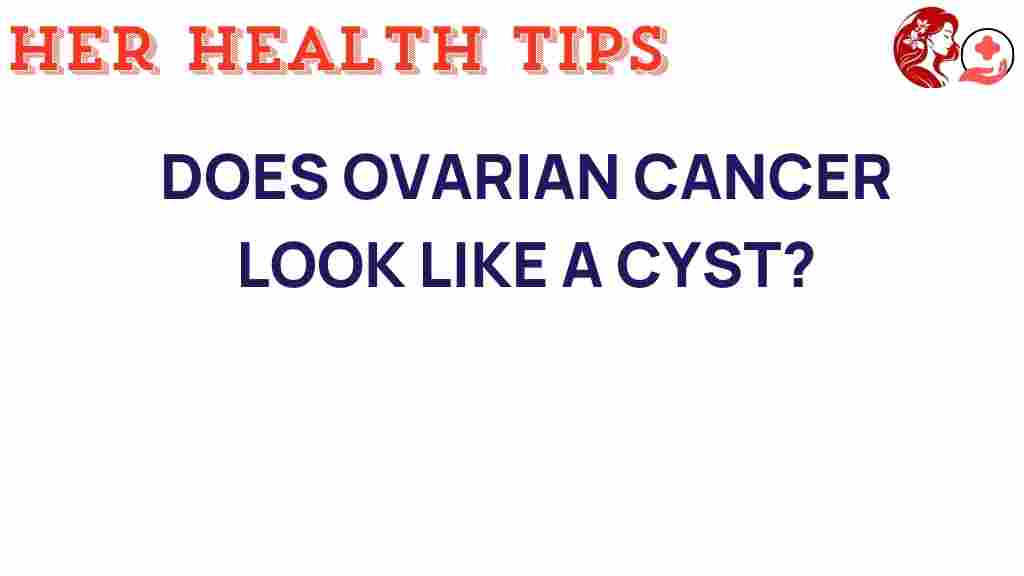Unveiling the Mystery: Does Ovarian Cancer Resemble a Cyst?
Ovarian cancer is a significant concern in women’s health, often shrouded in mystery due to its subtle symptoms and similarities to other conditions, particularly ovarian cysts. Understanding the differences between ovarian cancer and cysts is crucial for early detection and effective treatment. This article aims to unravel the complexities surrounding ovarian cancer, cyst symptoms, and the importance of cancer awareness in promoting women’s health.
Understanding Ovarian Cancer
Ovarian cancer occurs when abnormal cells in the ovaries grow uncontrollably. It is often called a “silent killer” because it frequently goes undetected until it reaches advanced stages. The risk factors for ovarian cancer include:
- Age: Women over 50 are at higher risk.
- Family history: A history of breast or ovarian cancer in the family increases risk.
- Genetic mutations: BRCA1 and BRCA2 gene mutations significantly elevate the risk.
- Endometriosis: This condition may increase the likelihood of developing ovarian cancer.
- Obesity: Higher body mass index (BMI) can contribute to risk.
Recognizing Cyst Symptoms
Ovarian cysts are fluid-filled sacs on the ovaries and are generally benign. However, they can exhibit symptoms that may be mistaken for ovarian cancer. Common cyst symptoms include:
- Pelvic pain: A persistent ache in the lower abdomen.
- Irregular periods: Changes in menstrual cycle frequency or duration.
- Bloating: A feeling of fullness or swelling in the abdomen.
- Urinary urgency: A frequent need to urinate.
- Difficulty emptying the bladder: A sensation of incomplete urination.
While these symptoms can indicate the presence of cysts, they can also overlap with those associated with ovarian cancer, making it essential for women to be vigilant about their health and report any changes to their healthcare providers.
Importance of Cancer Awareness and Early Detection
Raising awareness about ovarian cancer is critical for early detection. The earlier ovarian cancer is diagnosed, the better the chances of successful treatment. Women should be educated about the symptoms and risk factors associated with this type of cancer. Regular health check-ups and discussions about women’s health are vital in promoting awareness.
Some strategies for enhancing cancer awareness include:
- Participating in community health events focused on cancer education.
- Encouraging open conversations about women’s health in families.
- Utilizing online resources to learn more about ovarian cancer and cysts.
Medical Imaging and Diagnosis
When a woman presents symptoms that may indicate ovarian cancer or cysts, healthcare providers typically recommend medical imaging to assist in the diagnosis. Common imaging techniques include:
- Ultrasound: This is the most common imaging method used to examine the ovaries. It can help differentiate between cysts and solid masses.
- CT scans: These provide detailed images of the abdominal and pelvic organs and can help identify the extent of any tumors.
- MRI: This imaging technique is used for further evaluation of the ovaries, especially if there are concerns from other imaging results.
In addition to imaging, a thorough medical history and physical examination are essential parts of the diagnostic process. In some cases, healthcare providers may recommend blood tests, including a CA-125 test, which measures a specific protein that may be elevated in women with ovarian cancer.
Step-by-Step Process for Addressing Health Concerns
If you experience symptoms that may indicate ovarian cancer or cysts, follow these steps:
- Monitor symptoms: Keep track of any changes in your body, especially persistent pelvic pain or unusual menstrual changes.
- Schedule a visit with your healthcare provider: Discuss your symptoms openly and ask for a thorough evaluation.
- Undergo recommended imaging: Follow through with any suggested medical imaging to get a clearer picture of your ovarian health.
- Discuss results: Review the imaging and any blood test results with your healthcare provider to understand your condition.
- Follow up: Based on the findings, adhere to your provider’s recommendations, whether it involves treatment, further tests, or regular monitoring.
Troubleshooting Tips for Managing Symptoms
For those experiencing symptoms that may be related to cysts or ovarian cancer, here are some troubleshooting tips:
- Maintain a symptom diary: Document your symptoms, their frequency, and any potential triggers.
- Adopt a healthy lifestyle: Regular exercise and a balanced diet can help manage symptoms and improve overall health.
- Seek support: Join support groups or forums for women dealing with similar health issues.
- Stay informed: Educate yourself about ovarian health and available treatments.
By staying proactive about women’s health, women can reduce their risk factors and enhance their chances of early detection and successful treatment.
Conclusion
Ovarian cancer and cysts can share similar symptoms, making it crucial for women to be vigilant regarding their health. Understanding the risk factors associated with ovarian cancer and recognizing cyst symptoms can aid in early detection, which is vital for successful treatment outcomes.
By promoting cancer awareness and utilizing medical imaging and healthcare resources, women can take charge of their health. Remember, if you have any concerns about your ovarian health, do not hesitate to consult with your healthcare provider. Together, we can work towards reducing the impact of ovarian cancer on women’s lives.
For more information on women’s health and ovarian cancer, check out this resource. Additionally, if you want to learn more about healthcare initiatives focused on cancer awareness, visit this website.
This article is in the category Conditions and created by HerHealthTips Team
